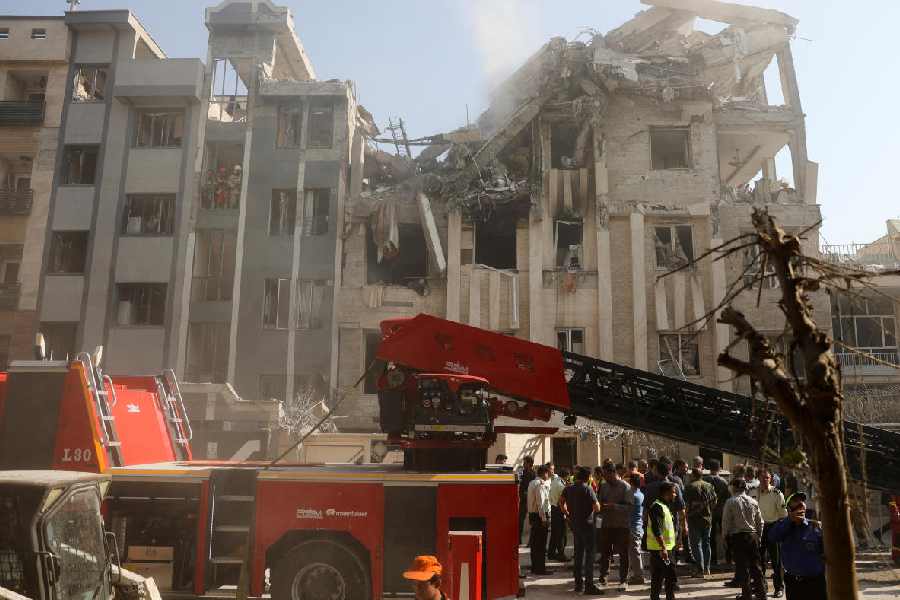 |
| A boat sails into the inner recesses of Halong Bay; (below) Stalactites and stalagmites create unreal sculptures within a limestone cave |
 |
The first thing that awaits us onboard the tourist boat at Haiphong pier is lunch. The spread is an anagram for gluttony. Fresh prawns, sautéed squid rings, Vietnamese spring rolls, fried rice. “Yummy yummy yummy!” grins Nam, our jovial tour operator (it’s the first of a series of exclamations to be thrown at us through the next 24 hours, justifying the $65 that his agency pocketed from each of us back in Hanoi). “Now I show you how Vietnamese people use chopsticks! First you take thumb…”
On another day, Nam’s words might have naturally provoked a spate of good-humoured clash of civilisations among a group of travellers from faraway lands. Today, however, no one seems interested.
Our boat has pulled away from the pier in the meantime, and the spectacle that we’ve all been eagerly waiting for has slowly begun to reveal itself from out of the ashen pall of mist that hangs over the horizon. The prawns go untouched, and Nam is left twirling his chopsticks as we make a frantic rush for the top deck, just in time to see our captain deftly steer our boat, Titanic-style, around a towering column of limestone jutting hundreds of feet out of the sea.
That’s when it finally sinks in. We’re in Halong Bay.
Located off the far north- eastern coastline of Vietnam, the unreal landscape of Halong Bay could easily have come off a page from a Narnia classic. Some 3,000 limestone outcrops of varying shapes and sizes riddle the still waters of the South China Sea over an area stretching 1,500-odd sq km. Within the folds of these breathtakingly beautiful cliffs, nature — still draped in its unspoilt prehistoric cloak — lolls youthfully in the ultramarine waters.
Legend has it that the gods once dispatched an army of dragons to assist the Vietnamese in their battle against Chinese marauders. Along with their fire breath, the dragons also spewed precious jewels that were embedded into the sea to form a wall against invaders. Pleased with their own creation, the dragons then decided to live here, and act as peacekeepers of this extraordinary landscape.
And peace, needless to say, does prevail. Silence rings like a thousand knells here; the cool unpolluted air is heavy with the smell of salt. The days are languid; the nights ethereal. The sea is unusually calm. Bordering on submissive, it entices mortals (much like a siren lures a sunburnt sailor) to embark on an adventure of a lifetime. If fantasies are of any worth, Halong Bay is perhaps the last place on earth where one can still play Ulysses.
 |
| A ship drops anchor in Halong Bay |
Nam, of course, will have none of this daydreaming. “Come I show you something special now,” he announces with a karaoke-like gesture (lip-syncing is a favourite pastime in Vietnam, for the record). So very soon, our boat docks at the Thien Cung Island (among the bigger massifs in the bay) and we find ourselves inching up the cliff along a steep stairway. It’s an exhausting exercise, but Nam assures us it’s worth the toil.
To be fair to the man, he’s right. Sneaking past a crack in the rock-face, we enter the Thien Cung grotto, and realise that it is undoubtedly among the most spectacular of nature’s creations. Thousands of years of geological serendipity has resulted in a fantastic grid-work of stalactites and stalagmites that create an intriguing pattern within a series of inter-connected caves. Now dramatically illuminated by the Vietnamese tourism authorities, they are a jaw-dropping sight. Nam has a sobriquet for the grotto. The “oh-my-god cave”, he calls it. Quite apt indeed.
The sun begins to slowly dip over the horizon by the time we emerge from the caves. Navigating away from Thien Cung Island, we drop anchor at a floating village at the base of a cliff. A strong and delightfully aromatic cup of Vietnamese filter coffee welcomes us on ‘land’, and is followed by a syrupy and bitter (but incredibly rejuvenating) serving of local green tea.
Meanwhile, a fleet of kayaks has been launched on the waters for those willing to explore the nearby waters on their own. I opt to stay dry, chatting up Nam instead. With a majority of the travelling party splashing about, Nam finally sits back and speaks easy.
The Vietnam War apparently took a massive toll on this virginal landscape, he says. The waters were relentlessly bombed by warplanes; channels between neighbouring islands were apparently mined to restrict the free movement of local boats. “But we Vietnam people have very strong will,” he grins. “So after war, we clean up and bring tourists back and now everything is fine. Halong Bay — number one!”
Despite the fact that the optimistic Vietnamese ascribe that last qualifier to even a regulation bowl of noodle soup, I can’t but agree with Nam.
Dusk slowly descends as we speak. Having exchanged pleasantries with our hosts in the village, we climb back on our boat — which by then has unfurled its junk-like sails — and cruise into the distance.
Anchor is soon dropped in the middle of nowhere. It’s raven dark by now, the cloak of darkness pierced only by the quivering lights of other tourist boats that bob like will-’-the-wisps in the eerie distance. A crack of lightning streaks a far corner of the sky, an indication that we’ll wake up to a wet dawn on the waters tomorrow. Rain out on the seas is quite a sight, we’re told. We can hardly wait.
Suddenly, Nam rushes onto the deck. “Dinner is ready,” he announces with a roll, imaginary microphone to mouth.
This time, the prawns will die a purposeful death.
Ready reckoner
 |
Getting there: Air Asia flies daily to Hanoi via Bangkok. Join an overnight tour (ranging from $60 to $200 per head) from Hanoi to Halong Bay.
Best time to visit: April and November, if the weather is forgiving. The conditions are ideal for taking great photographs.










